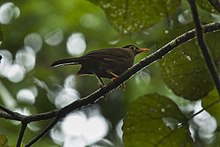Sulawesi thrush
| Sulawesi thrush | |
|---|---|

| |
| Scientific classification | |
| Domain: | Eukaryota |
| Kingdom: | Animalia |
| Phylum: | Chordata |
| Class: | Aves |
| Order: | Passeriformes |
| Family: | Turdidae |
| Genus: | Turdus |
| Species: | T. turdoides
|
| Binomial name | |
| Turdus turdoides (Hartert,1896)
| |
| Synonyms | |
|
Cataponera turdoidesHartert, 1896 | |
TheSulawesi thrush(Turdus turdoides) is aspeciesofpasserinebird in the thrush family,Turdidae.[2]It isendemicto the island ofSulawesiin Indonesia, where it inhabits evergreenmontane forestsat altitudes of 1,100–2,400 m (3,600–7,900 ft). Although it has a limited range and is not a common bird, theIUCNhas assessed it as being a "least-concern species".
Taxonomy
[edit]The Sulawesi thrush was formally described in 1896 by the German orthithologistErnst Hartertbased on specimens collected at 2,000 m (6,600 ft) altitude and above nearBantaengin southernSulawesi,Indonesia. Hartert introduced a newgenusCataponeraand coined thebinomial nameCataponera turdoides.[3][4]The taxonomic placement of this species remained uncertain since its description, with some authorities classifying it with thelaughingthrushes(family Leiotrichidae), while others classified with the truethrushes(family Turdidae). Since the 2000s, it was generally placed in the monotypic genusCataponerawithin the Turdidae, on morphological grounds. However, prior to a 2022 study, it was not yet placed phylogenetically. The study found the Sulawesi thrush to actually represent a highly divergent member of the genusTurdus,belonging in a clade comprising primarily migratoryPalearcticthrushes, but with no close relatives. TheInternational Ornithological Congresshas followed the results of this study.[5][6]
Description
[edit]The Sulawesi thrush is a medium-sized species with a long beak, short rounded wings and robust legs. The head and upper parts are a dark olive brown and the underparts are somewhat paler, sometimes with a gingery or reddish tinge to the under-tail coverts. There is a distinctive blacksuperciliumabove the eye.[7][8]
Distribution
[edit]The Sulawesi thrush isendemicto the island ofSulawesiin Indonesia.[1]Its habitat is evergreen montane forest and moss-forest and its altitudinal range lies between 1,100 and 2,400 m (3,600 and 7,900 ft). Four subspecies are recognised;T. t. abditivafrom the northern part of the island;T. t. tenebrosafrom the southern part;T. t. turdoidesfrom southwestern Sulawesi andT. t. heinrichifrom the southeast. It is not present in the central part of the island.[7]
Ecology
[edit]The Sulawesi thrush is a shy bird that is seldom seen and has been little studied.[8]The diet consists of fruits and invertebrates[7]and it forages in the middle and lower storeys of the canopy in evergreen montane forests, and on the ground beneath the trees. In behaviour and appearance it resembles thrushes in thegenusTurdus,but it has other behaviours which are similar to those of theOld World babblers(Timaliidae), and thelaughing thrushes(Garrulax).[8]
Status
[edit]The Sulawesi thrush has a somewhat restricted range and is a generally uncommon bird. The population is thought to be declining slowly but not at such a rate as to make it vulnerable, and theInternational Union for Conservation of Naturehas assessed its conservation status as being of "least concern".[1]
References
[edit]- ^abcBirdLife International (2016)."Cataponera turdoides".IUCN Red List of Threatened Species.2016:e.T22708538A94163855.doi:10.2305/IUCN.UK.2016-3.RLTS.T22708538A94163855.en.Retrieved12 November2021.
- ^Gill, Frank; Donsker, David, eds. (2016)."Thrushes".World Bird List Version 6.2.International Ornithologists' Union.Retrieved8 July2016.
- ^Hartert, Ernst(1896)."Preliminary descriptions of some new birds from the mountains of southern Celebes".Novitates Zoologicae.3:69-71 [70-71].
- ^Mayr, Ernst;Paynter, Raymond A. Jr, eds. (1964).Check-List of Birds of the World.Vol. 10. Cambridge, Massachusetts: Museum of Comparative Zoology. p. 161.
- ^Reeve, Andrew Hart; Blom, Mozes P. K.; Zahl Marki, Petter; Batista, Romina; Olsson, Urban; Edmark, Veronica Nyström; Irestedt, Martin; Jønsson, Knud Andreas (2022). "The Sulawesi Thrush (Cataponera turdoides;Aves: Passeriformes) belongs to the genusTurdus".Zoologica Scripta.51:32–40.doi:10.1111/zsc.12518.S2CID243816907.
- ^IOC World Bird List 12.1 (Report).doi:10.14344/ioc.ml.12.1.S2CID246050277.
- ^abcCollar, N. (2020)."Sulawesi Thrush (Cataponera turdoides) ".In del Hoyo, J.; Elliott, A.; Sargatal, J.; Christie, D.A.; de Juana, E. (eds.).Handbook of the Birds of the World Alive.Lynx Edicions.doi:10.2173/bow.sulthr1.01.S2CID216333793.Retrieved8 July2016.(subscription required)
- ^abcClement, Peter; Hathway, Ren (2010).Thrushes.Bloomsbury Publishing. p. 34.ISBN978-1-4081-3542-6.

